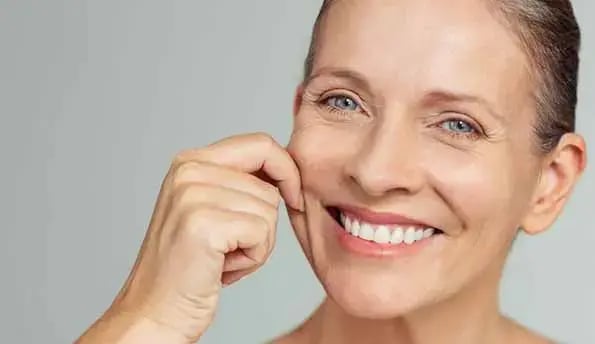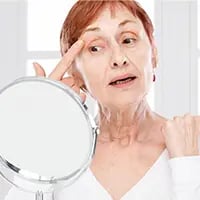What are Jowls?
Understanding and Defining Human Facial Jowls
Jowls refer to the sagging or drooping skin and flesh that hangs below the lower jawline and chin. They are most commonly associated with the aging process and occur as a result of a combination of factors such as loss of skin elasticity, decreased collagen production, and natural fat redistribution in the face. As we age, the skin's supportive structures, including collagen and elastin fibers, start to weaken, leading to a loss of firmness and elasticity. Additionally, the redistribution of facial fat and the gradual decrease in overall volume contribute to the development of jowls.
Jowls can vary in severity from mild sagging to more prominent and noticeable drooping. They can affect both men and women and are typically more pronounced in individuals with thinner skin or certain facial structures.
While aging is the primary cause of jowls, other factors such as genetics, sun exposure, smoking, and poor skincare habits can accelerate their development. Various cosmetic and non-surgical treatments are available to help minimize the appearance of jowls, including facial exercises, dermal fillers, skin-tightening procedures, and facelift surgery, depending on the individual's preferences and desired results.
Our mission is to create a world where every investment in modern beaty is Worth It.
Let's keep in touch
Get updates of the treatments you are interested
What Causes Jowls?
Jowls are the sagging or drooping skin and tissue that can form along the lower jawline and chin. They are a common sign of aging and can be caused by several factors:
1. Loss of skin elasticity: As we age, the production of collagen and elastin, which are responsible for skin firmness and elasticity, decreases. This loss of elasticity can lead to the sagging of facial skin, including the formation of jowls.
2. Decreased muscle tone: The muscles in the face can also contribute to the development of jowls. Over time, these muscles may weaken or lose tone, allowing the overlying skin to sag and form jowls.
3. Gravity: The natural force of gravity constantly pulls down on our facial tissues, contributing to the downward displacement of fat and skin. This effect is more pronounced in areas where the underlying support structures weaken, such as the jawline, resulting in the formation of jowls.
4. Genetics: Some individuals may be genetically predisposed to developing jowls. If your parents or other close relatives have prominent jowls, you may be more likely to develop them as well.
5. Lifestyle and habits: Certain lifestyle factors can accelerate the development of jowls. Factors such as smoking, excessive sun exposure, poor diet, and inadequate skincare can contribute to the breakdown of collagen and elastin, leading to the earlier onset of jowls.
6. Weight loss: Significant weight loss can also contribute to the appearance of jowls. When a person loses a substantial amount of weight, the skin may not fully retract and tighten, resulting in sagging skin around the jawline and chin.
What Can I Do to Reduce My Risk?
1. Maintain a healthy lifestyle
2. Protect your skin from the sun
3. Facial exercises
4. Skincare routine
5. Maintain a healthy weight
6. Consider surgical or non-surgical treatments

Surgical & Non-surgical Options?
Non-Surgical Options:
1. Dermal Fillers: Injectable dermal fillers, such as hyaluronic acid-based fillers, can be used to restore volume to the mid-face and minimize the appearance of jowls. By injecting fillers strategically, a skilled practitioner can provide a subtle lift and improve the jawline contour.
2. Thread Lift: This minimally invasive procedure involves inserting dissolvable sutures beneath the skin to lift and reposition sagging facial tissues, including the jowls. Over time, the threads stimulate collagen production, further enhancing the results.
3. Ultherapy: Using focused ultrasound energy, Ultherapy can stimulate collagen production and tighten the skin, leading to a lifting effect. It is a non-invasive treatment that can help improve the appearance of jowls.
4. Radiofrequency (RF) Treatments: RF treatments, such as Thermage or Profound, use radiofrequency energy to heat the deep layers of the skin, promoting collagen remodeling and tightening. These treatments can help reduce the appearance of jowls.
Surgical Options:
1. Facelift: A facelift, or rhytidectomy, is a surgical procedure that addresses jowls and other signs of facial aging. It involves removing excess skin, tightening underlying facial tissues, and repositioning the skin for a more youthful appearance.
2. Neck Lift: Often performed in conjunction with a facelift, a neck lift specifically targets the sagging skin and muscle bands in the neck area, including the jowls. It can involve removing excess skin, tightening underlying muscles, and redefining the jawline.
3. Liposuction: In cases where excess fat contributes to the appearance of jowls, liposuction may be performed to remove the fat deposits. This surgical procedure suctions out the excess fat, improving the contour of the jawline.
4. Kybella: Although not a surgical procedure, Kybella involves injecting a synthetic form of deoxycholic acid into the jowl area to reduce fat and improve the jawline contour. It is a minimally invasive treatment, but it may require multiple sessions for optimal results.
Our mission is to create a world where every investment in modern beaty is Worth It.
Let's keep in touch
Get updates of the treatments you are interested
Understanding and Defining Human Facial Jowls
Jowls refer to the sagging or drooping skin and flesh that hangs below the lower jawline and chin. They are most commonly associated with the aging process and occur as a result of a combination of factors such as loss of skin elasticity, decreased collagen production, and natural fat redistribution in the face. As we age, the skin's supportive structures, including collagen and elastin fibers, start to weaken, leading to a loss of firmness and elasticity. Additionally, the redistribution of facial fat and the gradual decrease in overall volume contribute to the development of jowls.
Jowls can vary in severity from mild sagging to more prominent and noticeable drooping. They can affect both men and women and are typically more pronounced in individuals with thinner skin or certain facial structures.
While aging is the primary cause of jowls, other factors such as genetics, sun exposure, smoking, and poor skincare habits can accelerate their development. Various cosmetic and non-surgical treatments are available to help minimize the appearance of jowls, including facial exercises, dermal fillers, skin-tightening procedures, and facelift surgery, depending on the individual's preferences and desired results.
Our mission is to create a world where every investment in modern beaty is Worth It.
Let's keep in touch
Get updates of the treatments you are interested
What Causes Jowls?
Jowls are the sagging or drooping skin and tissue that can form along the lower jawline and chin. They are a common sign of aging and can be caused by several factors:
1. Loss of skin elasticity: As we age, the production of collagen and elastin, which are responsible for skin firmness and elasticity, decreases. This loss of elasticity can lead to the sagging of facial skin, including the formation of jowls.
2. Decreased muscle tone: The muscles in the face can also contribute to the development of jowls. Over time, these muscles may weaken or lose tone, allowing the overlying skin to sag and form jowls.
3. Gravity: The natural force of gravity constantly pulls down on our facial tissues, contributing to the downward displacement of fat and skin. This effect is more pronounced in areas where the underlying support structures weaken, such as the jawline, resulting in the formation of jowls.
4. Genetics: Some individuals may be genetically predisposed to developing jowls. If your parents or other close relatives have prominent jowls, you may be more likely to develop them as well.
5. Lifestyle and habits: Certain lifestyle factors can accelerate the development of jowls. Factors such as smoking, excessive sun exposure, poor diet, and inadequate skincare can contribute to the breakdown of collagen and elastin, leading to the earlier onset of jowls.
6. Weight loss: Significant weight loss can also contribute to the appearance of jowls. When a person loses a substantial amount of weight, the skin may not fully retract and tighten, resulting in sagging skin around the jawline and chin.
What Can I Do to Reduce My Risk?
1. Maintain a healthy lifestyle
2. Protect your skin from the sun
3. Facial exercises
4. Skincare routine
5. Maintain a healthy weight
6. Consider surgical or non-surgical treatments

Surgical & Non-surgical Options?
Non-Surgical Options:
1. Dermal Fillers: Injectable dermal fillers, such as hyaluronic acid-based fillers, can be used to restore volume to the mid-face and minimize the appearance of jowls. By injecting fillers strategically, a skilled practitioner can provide a subtle lift and improve the jawline contour.
2. Thread Lift: This minimally invasive procedure involves inserting dissolvable sutures beneath the skin to lift and reposition sagging facial tissues, including the jowls. Over time, the threads stimulate collagen production, further enhancing the results.
3. Ultherapy: Using focused ultrasound energy, Ultherapy can stimulate collagen production and tighten the skin, leading to a lifting effect. It is a non-invasive treatment that can help improve the appearance of jowls.
4. Radiofrequency (RF) Treatments: RF treatments, such as Thermage or Profound, use radiofrequency energy to heat the deep layers of the skin, promoting collagen remodeling and tightening. These treatments can help reduce the appearance of jowls.
Surgical Options:
1. Facelift: A facelift, or rhytidectomy, is a surgical procedure that addresses jowls and other signs of facial aging. It involves removing excess skin, tightening underlying facial tissues, and repositioning the skin for a more youthful appearance.
2. Neck Lift: Often performed in conjunction with a facelift, a neck lift specifically targets the sagging skin and muscle bands in the neck area, including the jowls. It can involve removing excess skin, tightening underlying muscles, and redefining the jawline.
3. Liposuction: In cases where excess fat contributes to the appearance of jowls, liposuction may be performed to remove the fat deposits. This surgical procedure suctions out the excess fat, improving the contour of the jawline.
4. Kybella: Although not a surgical procedure, Kybella involves injecting a synthetic form of deoxycholic acid into the jowl area to reduce fat and improve the jawline contour. It is a minimally invasive treatment, but it may require multiple sessions for optimal results.
Our mission is to create a world where every investment in modern beaty is Worth It.
Let's keep in touch
Get updates of the treatments you are interested
Related Treatments
.webp?width=200&height=200&name=thread-lift%20(1).webp)
Thread Lift

Neck Lift

Blepharoplasty (Eyelid Surgery)

Buccal Fat Removal (Bichectomy)
.webp?width=200&height=200&name=thread-lift%20(1).webp)
Thread Lift

Neck Lift

Blepharoplasty (Eyelid Surgery)








